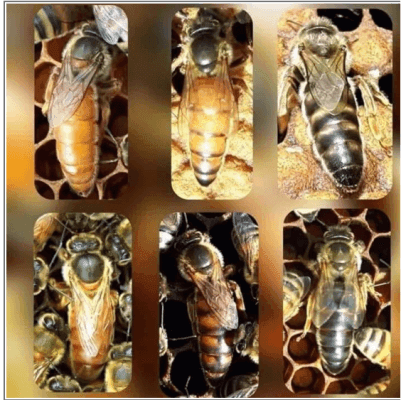‘I’m really scared of bees’ — we hear this phrase so often that we’re starting to become afraid of bees ourselves… We’re joking, of course! It’s really quite the opposite: the more we hear about people’s fear of these unique creatures, the more we want to cure them of it. This time we decided to share our knowledge of queen bees. Do you know everything there is to know about them?
We’ll begin with the fact that queen bees have magical powers! You couldn’t call it anything else because they live as many as 4–5 years, while worker bees only live 30–40 days. The secret to their longevity lies in royal jelly, which the queen bee’s larva gets fed much longer than the larvae of the worker bees. So, royal jelly is the key to a long life!
Typically, a bee colony consists of 20,000–80,000 worker bees and just one queen bee. Can you imagine? That’s some mother! The queen bee never collects honey, her job is to lay eggs. The queen bee can lay up to 2,500 eggs a day – that’s more than she weighs herself!
Because we’ve touched upon the topic of bee reproduction, we’ll share a few more personal or even intimate details of the queen bee’s life. They don’t mate in the hive but rather fly out on a ‘date’, during which they mate with up to 20–45 different drones. Just to make sure! Queen bees have a special organ for collecting the sperm of drones. The queen bee can mate just once, and she has enough sperm to last her a lifetime.
Did you know that queen bees lay both fertilised and unfertilised eggs? The fertilised eggs develop into worker bees, while the unfertilised eggs develop into drones. The queen bees themselves decide how many male bee eggs to lay. Drones inherit only the queen bee’s genes, while worker bees inherit both the genes of the queen bee and the drones.
Drones, just like the queen bees, do not harvest honey. They fly around and look for unfertilised females — young queen bees. However, they can only enjoy this carefree life in the summer. To make sure there are no unnecessary mouths to feed, in the fall, the worker bees simply lead the drones out of the hive. No one wants idlers around!
 The greatest burden falls to the worker bees. They are the hive’s superpower! Day after day, worker bees scout around and protect their territory, harvest nectar and build wax honeycomb cells. When the queen bee dies, they don’t mourn for long and grow themselves a new queen bee. In the hive, just like in human life, good positions don’t go empty for long!
The greatest burden falls to the worker bees. They are the hive’s superpower! Day after day, worker bees scout around and protect their territory, harvest nectar and build wax honeycomb cells. When the queen bee dies, they don’t mourn for long and grow themselves a new queen bee. In the hive, just like in human life, good positions don’t go empty for long!
In Lithuania, there are three types of bees: Buckfast, Carniolan and Italian bees. Buckfast bees are the most productive and peaceful. Original Buckfast queen bees and their families are an ideal choice for younger or novice beekeepers. Read about Buckfast queen bees HERE.





